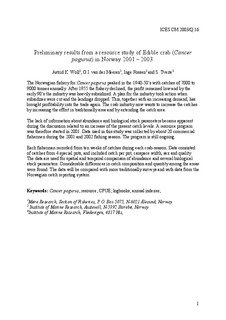Preliminary results from a resource study of edible crab (Cancer pagurus) in Norway 2001- 2003
Original version
This report is not to be cited without prior reference to the authorsAbstract
The Norwegian fishery for Cancer pagurus peaked in the 1940-50’s with catches of 7000 to 9000 tonnes annually. After 1955 the fishery declined, the profit remained low and by the early 90’s the industry was heavily subsidized. A plan for the industry took action when subsidizes were cut and the landings dropped. This, together with an increasing demand, has brought profitability into the trade again. The crab industry now wants to increase the catches by increasing the effort in traditionally area and by extending the catch area.
The lack of information about abundance and biological stock parameters became apparent during the discussion related to an increase of the present catch levels. A resource program was therefore started in 2001. Data used in this study was collected by about 20 commercial fishermen during the 2001 and 2002 fishing season. The program is still ongoing.
Each fisherman recorded from ten weeks of catches during each crab-season. Data consisted of catches from 4 special pots, and included catch per pot, carapace width, sex and quality. The data are used for spatial and temporal comparison of abundance and several biological stock parameters. Considerable differences in catch composition and quantity among the areas were found. The data will be compared with more traditionally surveys and with data from the Norwegian catch reporting system.
